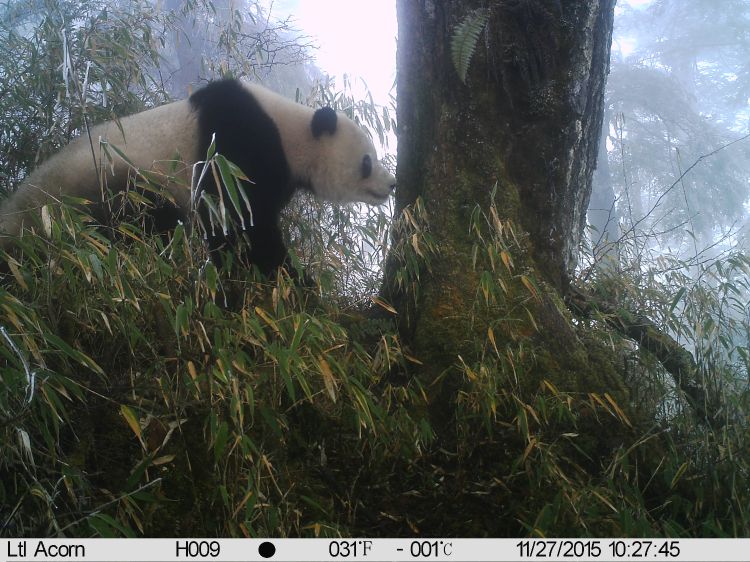Pandas, long portrayed as solitary beasts, do hang with family and friends, and they’re big users of social media. Scent-marking trees serve as a panda version of Facebook.
New research paints a lifestyle picture of the beloved bears in China’s Wolong Nature Reserve, a life that’s shielded from human eyes because they’re shy, rare, and live in densely forested, remote areas.
No one really knows how pandas hang, but the new study indicates pandas are around others more than previously thought. They use scent marking to keep track of both family members and friends, leave updates about life events, and check out the dating scene.

Thomas Connor, lead author of the study in the journal Ursus, spent months watching for signs of pandas, since actual pandas are virtually invisible. The work, for his PhD from Michigan State University’s Center for Systems Integration and Sustainability, built on previous observations by other MSU-CSIS scientists who suspected pandas likely weren’t the total loners everyone thought.
“Once you’ve gotten an eye for it, you can see on ridge tops and different trails the scent-marking trees, which are stained with a waxy substance—and the pandas seem to be doing this a lot,” Connor says. “It was pretty evident they were exchanging information through scent marking behavior.”
To link the marked trees with an understanding of panda’s social structure, the researchers needed to document nearby panda communities. To explore that hunch, Connor teamed up with coauthor Ken Frank, a professor of sociometrics and an expert on social networks.
The researchers didn’t have a camera on a bear every time it sniffs a tree. “That’s a key part,” Frank says. “I told him that once he has data on which bears are close to each other we can use the techniques and theories that apply to humans to understand their social networks.
“And these scent trees are a social media. Like Facebook, it’s asynchronous, meaning you don’t have to be in the same place at the same time. It allows one to broadcast to many, and it’s a record. A panda marking a tree isn’t so different from a Facebook post.”
Panda poop offers social insight
To determine which bears were close to each other, Connor dug into a wealth of data he had collected in the form of fresh panda poop.
Panda scat is the gold standard of panda watching. What pandas lack in obvious sociability they make up for in poop production—going some 90 times a day. That means they leave a reliable trail. Connor was able to extract DNA from the fresh panda poop he and his colleagues collected in a 46 square kilometer area known as prime panda habitat.
Information from the scat allowed them to identify specific pandas in the vicinity of the scent-marking trees, and showed if these pandas were related to each other. That allowed them to combine that with the information from their chosen communication method—the scent trees—to explore their social network.
“We defined two panda individuals within a certain distance from each other as an association, Connor says. “Even if they’re not directly communicating or running into each other physically—they can exchange information in the chemical scent signature. That built up the social network for the analysis.”
Which was a revelation for an animal thought of as a loner.
Panda cliques: Who’s in and who’s out?
Once they could determine the bears were in proximity, the researchers could apply the social network technique of community or clique detection, Frank says.
“It’s pretty much like high school,” Frank says. “And like in high school, cliques have lots of implications. There are strong norms within a clique—and while encountering those outside a clique is rare the information can be very important.”
The scent-marking trees are ripe with information, telling the sniffer who the animal is if they’ve encountered them before. It also tells the marker’s sex, an idea of how dominant and large the bear is, and whether they’re ready to mate.
The most tantalizing information they gleaned is that in non-mating seasons, the pandas seem to be hanging mostly with other family members, Frank says. But they seemed to branch out in mating seasons—likely using the scent-marking trees as a territory map.
That’s an important behavioral change, since moving out of the family groups during mating season both reduces the changes of inbreeding and competition. Connor notes this result was preliminary and limited by small sample sizes, but a tantalizing one that should be followed up on.
“The discoveries in this study shed new light on how pandas use their habitat,” says senior author Jianguo “Jack” Liu, chair in sustainability and CSIS director. “Pandas are a part of coupled human and natural systems where humans share their habitat. Anything we can learn about how they live and what they need can ultimately help inform good conservation policies and maybe understand our own behavior a little more.”
The National Science Foundation supported the work.
Source: Michigan State

